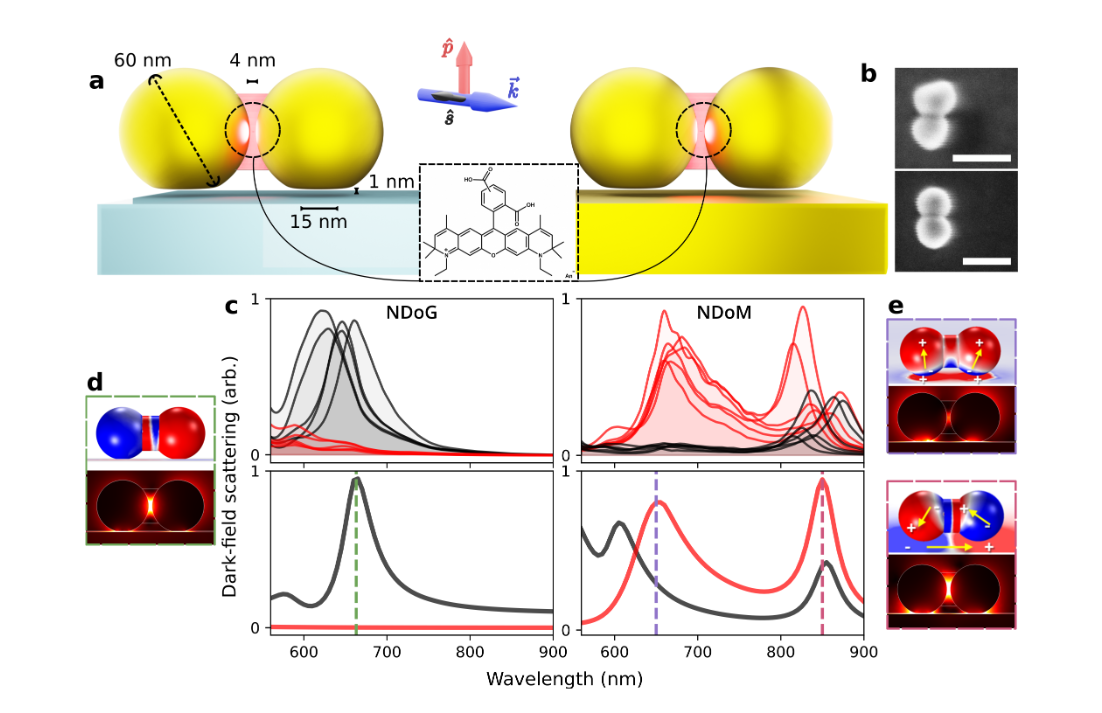The effectiveness of the DNA origami method for placing molecules into plasmonic nanocavities
In the realm of modern technology, controlling light at the smallest scales is crucial for advancements in areas like medical imaging, environmental sensing, and the development of new computing technologies. A recent study 1 explores innovative methods to manipulate light emission from individual molecules, paving the way for significant progress in these fields.
The role of plasmonic nanocavities
Molecules can emit light, a phenomenon utilized in various applications such as fluorescent markers in biological research. The efficiency and characteristics of this light emission depend on the molecule’s environment. By altering this environment, scientists can modify how molecules emit light, enhancing their performance for specific applications.
One effective way to control molecular light emission is by placing the molecule inside a tiny structure known as a plasmonic nanocavity. These nanocavities can concentrate light into extremely small volumes, intensifying the interaction between light and the molecule. This intensified interaction can significantly alter the properties of the emitted light.
Innovative assembly using DNA origami
A major challenge in this approach is the precise placement of a single molecule within the nanocavity. The study addresses this by employing a technique called DNA origami, which involves folding DNA strands into specific shapes that can serve as scaffolds. This method allows for the accurate positioning of molecules within nanocavities, ensuring optimal interaction between the molecule and the confined light.

The researchers discovered that molecules placed inside these nanocavities exhibited significant changes in their light emission properties. Two notable effects observed were:
- Purcell Broadening: This refers to the enhancement of the molecule’s ability to emit light. The study found that the emission rate of the molecules increased substantially, meaning they could emit light more efficiently.
- Lamb Shift: This involves a shift in the energy levels of the molecule, leading to changes in the color (wavelength) of the emitted light. The researchers observed significant shifts, indicating a strong interaction between the molecule and the nanocavity.
These effects were achieved using commercially available fluorescent molecules, demonstrating the practicality of the approach. The observed changes were comparable to those reported in more complex experimental setups, highlighting the effectiveness of the DNA origami method.
Implications for future technologies
The ability to control light emission at such a fundamental level has profound implications.
- Quantum Light Sources: The findings are relevant for developing tiny, fast light sources that can emit single particles of light (photons) on demand. Such sources are essential for future technologies like quantum computing and secure communication systems.
- Medical Imaging and Sensing: Enhanced control over molecular light emission can improve techniques in medical imaging and environmental sensing, leading to more accurate diagnostics and monitoring.
- Infrared Applications: The approach may enable the design of efficient light-emitting molecules for infrared applications, where traditional organic molecules often perform poorly.
A scalable and practical method
This study showcases a scalable and practical method to manipulate light emission from individual molecules by precisely positioning them within plasmonic nanocavities using DNA origami. The significant enhancements in light emission properties observed open new avenues for research and development in various fields, including quantum technologies, medical imaging, and environmental sensing. As scientists continue to explore and refine these techniques, we can anticipate further breakthroughs that will harness the power of light at the nanoscale, leading to innovative solutions to complex challenges.
Author: César Tomé López is a science writer and the editor of Mapping Ignorance
Disclaimer: Parts of this article may have been copied verbatim or almost verbatim from the referenced research paper/s.
References
- Sachin Verlekar, Maria Sanz-Paz, Mario Zapata-Herrera, Mauricio Pilo-Pais, Karol Kołątaj, Ruben Esteban, Javier Aizpurua, Guillermo P. Acuna, and Christophe Galland (2025) Giant Purcell Broadening and Lamb Shift for DNA-Assembled Near-Infrared Quantum Emitters ACS Nano doi: 10.1021/acsnano.4c09829 ↩